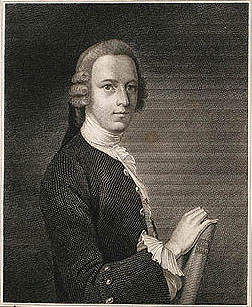Nicholas Revett facts for kids
Nicholas Revett (born 1720, died 1804) was a British architect. He is most famous for his work with James "Athenian" Stuart. Together, they recorded the ancient ruins of Athens, Greece. Some people called him an amateur architect, but he was very important in bringing back the Greek style of architecture.
Nicholas Revett was likely born in Framlingham, Suffolk, England. His family lived nearby in Brandeston. He was baptized in the Church of St Michael the Archangel in Framlingham.
He studied painting with Marco Benefial, who was an early artist of the Neoclassical style. Revett passed away in London and was buried in Brandeston.
Contents
First Adventure to Greece
Revett met James Stuart in Italy. Both men were there to improve their art skills. They decided to travel to Greece together. Before going to Greece, they met Sir James Gray, a British official in Venice. Through him, they became members of the Society of Dilettanti in London. This group of wealthy men, who had traveled a lot, gave important support to Revett's work.
In Greece, Revett and Stuart mostly stayed in Athens, arriving in 1751. They also visited some Aegean Islands, like Delos.
The Antiquities of Athens Book
Back in England, Revett and Stuart got their work ready to be published. They found people to pay for their book, called The Antiquities of Athens. This project was planned to have four main books, plus an extra one. The books included 368 detailed pictures, plans, and maps.
Another French artist, Julien-David Le Roy, published his book about ancient Greek buildings before Revett and Stuart. However, Revett and Stuart's work was much more accurate. This makes their survey the first of its kind for studying ancient Greece. For example, they were the first Europeans to describe that ancient Greek statues and buildings were often painted with bright colors, a style called polychromy.
The first book came out in 1762 or 1763. It described the authors as "painters and architects." Revett stopped working on the project after the first book. Stuart continued until he died in 1788. The fourth book was published in 1816. This was the same year the famous Elgin Marbles were bought by the British government.
Second Adventure
Revett went on a second trip in the 1760s. He traveled with Richard Chandler and others to Greece and Ionia. This trip was also supported by the Society of Dilettanti. It seems he and Stuart had a disagreement after the first book was published.
The instructions for this trip, given on May 17, 1764, were clear. The travelers were to make Smyrna their main base. From there, they would explore nearby ancient ruins. They were to make exact plans and measurements. They also had to draw detailed pictures of carvings and decorations. They copied all the old writings they found and kept daily notes.
Buildings Designed by Nicholas Revett
Nicholas Revett did not design many buildings. He saw himself as a gentleman and was likely wealthy enough not to need to work for money. However, he did have some "money troubles" later in his life.
Greek-Style Additions
Revett designed two 'Greek' additions to large English country houses. These additions helped start the British 'Greek Revival' period in architecture, beginning in the 1760s. Both house owners were members of the Society of Dilettanti. The houses were:
- Standlynch Park, Wiltshire, now called Trafalgar Park.
- Revett added a portico (a porch with columns) to this house. It belonged to Henry Dawkins, whose brother James Dawkins was Revett's friend and fellow explorer.
- West Wycombe Park, Buckinghamshire.
- Revett added the west portico to this house in 1771. It was the home of Sir Francis Dashwood. This portico was based on a temple of Bacchus in Teos, an ancient city. The Bacchus theme fit Sir Francis's love for lively parties, which was common among the Dilettanti. The ceiling design was copied from a building in Palmyra, as shown in Robert Wood's book "Ruins of Palmyra".
Complete Building
- The Rectory, Mereworth, Kent (now called Mere House).
- This house was designed in 1780 for Sir Francis Dashwood, who supported the local church. It is the only complete house Revett is known to have designed. The builder was Luffman Atterbury, who had also worked for Dashwood at West Wycombe. Some changes were made around 1830 and 1876, but many of Revett's original designs remain.
Church Design
Ayot St Lawrence Church in Hertfordshire was built in the 1770s. It has been specially mentioned by many, including the person who wrote about Revett's death in The Gentleman's Magazine. Lionel Cust also highlighted it in the Dictionary of National Biography.
Main Works
- with James Stuart: The Antiquities of Athens (1762).
- Richard Chandler, Nicholas Revett: Travels in Asia Minor and Greece.
- Richard Chandler, Nicholas Revett, W. Pars: Ionian Antiquities London 1769. [1].


